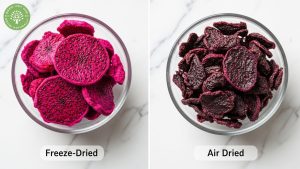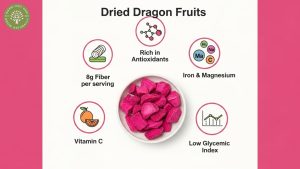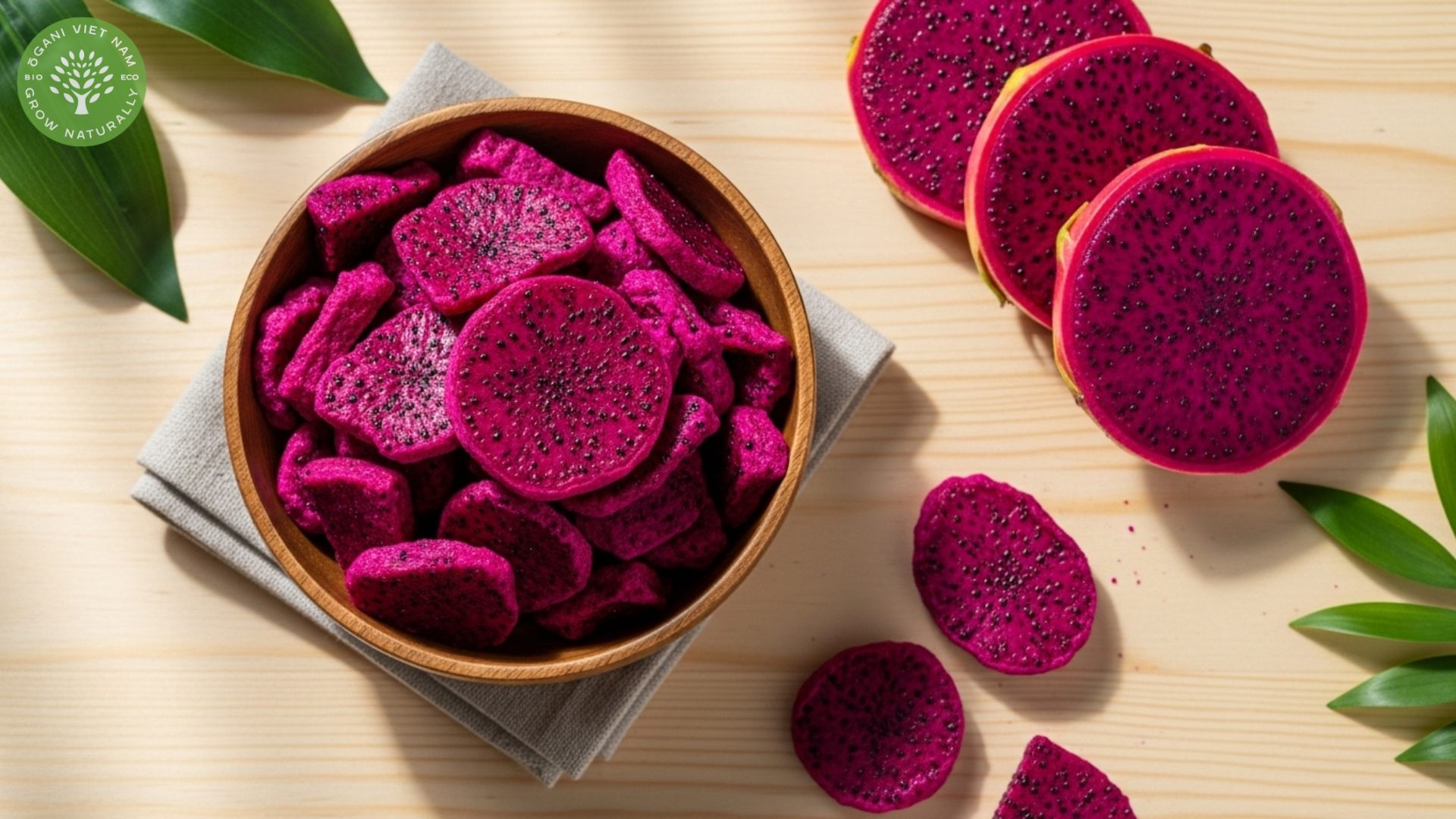Looking for a healthy snack that’s both vibrant and nutritious? Dragon fruit dried offers all the tropical goodness of fresh pitaya in a convenient, shelf-stable form. At Ogani VN, we’ve watched this exotic treat transform from a curiosity into a pantry staple for health-conscious snackers—and honestly, once you understand what makes it special, you’ll see why it’s worth the hype.
Dried dragon fruit isn’t just another trendy superfood. It’s perfectly ripe pitaya that’s been carefully dehydrated to lock in nutrients, intensify natural sweetness, and create that satisfying crispy-chewy texture everyone raves about. Whether you’re sprinkling it on your morning yogurt or munching it straight from the bag during your afternoon slump, this vibrant pink snack delivers both flavor and function.
What makes dragon fruit dried different from other dried fruits?

Here’s something most people don’t realize until they try it: not all dried fruits are created equal. Walk down any grocery aisle and you’ll see dried mangoes swimming in added sugar, banana chips deep-fried in oil, or raisins that taste nothing like grapes anymore. But high-quality dragon fruit dried products? They’re in a category of their own.
The best versions—like what we source at Ogani VN—use either freeze-drying or low-temperature dehydration methods. Freeze-dried dragon fruit maintains that airy, crunchy texture that literally melts on your tongue, while traditionally dried pieces offer a chewier, more concentrated bite. Both methods preserve the fruit’s natural sweetness without dumping in extra sugar (because really, who needs that?).
What sets pitaya apart is its naturally mild, subtly sweet flavor. Fresh dragon fruit is known for being refreshing but not overly sugary, and that carries through to the dried version. You get this delicate taste—almost like a gentle kiwi-meets-pear situation—that doesn’t overwhelm your palate. Plus, that stunning magenta color? It’s not food coloring. It’s pure betalain pigments, the same antioxidants that give beets their deep hue.
The texture surprise is real. First-timers often expect something leathery like dried apricots, but freeze-dried dragon fruit chunks dissolve almost instantly with a crispy snap. It’s wild how something so light can pack such intense flavor. One customer told us it reminded them of astronaut ice cream, except actually healthy and way more Instagram-worthy.
Dragon fruit dried health benefits that go beyond the pretty pink color

Let’s talk nutrition, because this is where dragon fruit dried really earns its superfood badge. We’re not just throwing that term around—this stuff genuinely brings nutritional value to your snack game.
First up: fiber content. A typical serving (about 40g) delivers around 8 grams of dietary fiber. That’s roughly a third of what most adults need daily, packed into a handful of crispy pieces. This matters more than you might think—fiber keeps your digestive system running smoothly, helps stabilize blood sugar levels, and keeps you feeling full longer. At Ogani VN, we’ve had customers mention they keep dried dragon fruit at their desk specifically for that 3 PM hunger that usually leads to vending machine regrets.
The antioxidant profile is legitimately impressive. Those betalains we mentioned? They’re powerful free radical fighters that support cellular health and may help reduce inflammation. Dragon fruit also contains vitamin C—though admittedly, some of that diminishes during the drying process. But here’s the thing: the concentration of certain minerals actually increases when water is removed. You get more iron, magnesium, and calcium per gram compared to fresh fruit.
Then there’s the fact that quality dried dragon fruit products are usually just… dragon fruit. No preservatives, no sulfites, no mysterious ingredients you can’t pronounce. Just fruit. When you’re reading labels at the store (which you absolutely should), look for products that list only one ingredient. If there’s a novel’s worth of additives, keep looking.
One aspect we particularly appreciate: dried dragon fruit is naturally low on the glycemic index compared to many dried fruits. It won’t send your blood sugar on a rollercoaster ride, which makes it a smarter choice for sustained energy. We’ve even had diabetic customers check with their doctors and get the green light to incorporate it into their meal plans.
Creative ways to use dragon fruit dried beyond snacking
Sure, eating dragon fruit dried straight from the bag is perfectly valid. But if you’re not exploring other uses, you’re missing out on some genuinely fun culinary possibilities.
The Starbucks pink drink phenomenon introduced millions of people to dried dragon fruit pieces as a beverage topper. And look, we get it—there’s something satisfying about those vibrant pink chunks floating in your iced drink. But why stop at recreating coffee shop vibes? Blend freeze-dried dragon fruit into smoothies for natural color and a subtle flavor boost without adding liquid. Seriously, just a tablespoon transforms a basic berry smoothie into something that looks like it came from a tropical resort.
Breakfast applications are where things get interesting. Stir dried dragon fruit pieces into overnight oats—they rehydrate slightly by morning, adding pops of texture and sweetness. Sprinkle them over acai bowls (yes, superfood on superfood—we don’t make the rules). Mix them into pancake or waffle batter for flecks of pink throughout. At Ogani VN, one of our team members crushes freeze-dried dragon fruit into a powder and swirls it into Greek yogurt for what she calls “dragon fruit fool”—a riff on the classic British dessert.
Baking with dried dragon fruit opens unexpected doors. Fold chunks into muffin batter, scatter them atop cookies before baking, or blend the powder into buttercream frosting for naturally pink icing. The mild flavor won’t compete with other ingredients, but the color payoff is stunning. We’ve seen customers use it for naturally dyed birthday cakes that actually taste good (unlike certain other natural dyes that shall remain nameless).
Don’t overlook savory applications either. Rehydrate dried dragon fruit in warm water for about 10 minutes, then dice it into fruit salsas for fish tacos. The subtle sweetness and slight acidity balance beautifully against savory proteins. Or keep it crispy and toss it into salads for textural contrast—particularly good with arugula, goat cheese, and a citrus vinaigrette.
Trail mix game-changer alert: combine dragon fruit dried with raw cashews, dark chocolate chips, and a sprinkle of sea salt. That sweet-salty-crunchy combination hits differently than your standard raisin situation. Pack it for hiking, keep it in your car for road trips, or portion it into small bags for your kids’ lunchboxes. The visual appeal alone makes it more exciting than another granola bar.
How to choose quality dragon fruit dried (what the labels won’t tell you)
Walking into a store or scrolling through online options can feel overwhelming. Bags of dragon fruit dried range from suspiciously cheap to mortgage-payment expensive, and it’s not always clear what you’re paying for. Let’s decode this.
First, understand the difference between freeze-dried and traditionally dried dragon fruit because they’re completely different animals. Freeze-dried involves flash-freezing the fruit, then removing moisture in a vacuum chamber. This preserves more nutrients, creates that signature airy crunch, and maintains bright color. It’s more expensive to produce, which is why freeze-dried options cost more. Traditional drying uses low heat over many hours, resulting in chewier pieces with slightly more concentrated flavor but potentially less nutrient retention.
Neither method is “better”—they serve different purposes. At Ogani VN, we stock both because some customers want that crispy snack experience while others prefer the chewier texture for baking or rehydrating. Know what you’re buying based on your intended use.
Check the ingredient list obsessively. This cannot be stressed enough: quality products list only “dragon fruit” or “pitaya.” Some manufacturers sneak in cane sugar, corn syrup, or sulfites as preservatives. Dragon fruit is naturally sweet enough—added sugar is unnecessary and defeats the health benefits you’re seeking. We’ve seen products claiming to be “natural” while containing three types of added sweeteners. Don’t fall for it.
Color tells a story. High-quality dragon fruit dried retains vibrant pink or magenta hues. If the pieces look dull, brownish, or faded, that suggests over-processing, old stock, or poor storage conditions. Fresh freeze-dried dragon fruit should almost glow—that intense color indicates preserved nutrients and proper handling.
Texture matters for quality assessment too. Freeze-dried pieces should be uniformly crispy and lightweight, never soggy or sticky. If you’re buying in-store and can gently press the bag (don’t be weird about it), properly dried fruit should feel crispy through the packaging. Any moisture or clumping suggests the product wasn’t dried thoroughly or the packaging isn’t properly sealed.
Origin and sourcing practices deserve attention. Dragon fruit grows primarily in tropical regions—Vietnam, Thailand, Colombia, and parts of Central America. Products from these regions often offer better quality because the fruit doesn’t travel as far before processing. At Ogani VN, we prioritize Vietnamese-grown dragon fruit not just for quality but because supporting local agriculture matters. The fruit is harvested at peak ripeness and processed quickly, which impacts final product quality.
Certifications can guide your choice. Look for USDA Organic if pesticide-free matters to you. Non-GMO Project Verified, while dragon fruit isn’t typically genetically modified, signals overall quality standards. Vegan and gluten-free certifications are common (dragon fruit naturally fits both) but their presence indicates the manufacturer took time for proper verification.
Storing dragon fruit dried to maintain freshness and flavor
You’ve invested in quality dragon fruit dried—now don’t let it go stale because of sloppy storage. This matters more than people realize, especially with freeze-dried varieties that are essentially moisture magnets.
The cardinal rule: keep it airtight and away from humidity. Freeze-dried dragon fruit can absorb moisture from the air within hours if left exposed, transforming from crispy to chewy to potentially moldy. Once you open a package, transfer any unused portion to an airtight container or use a clip to seal the original bag tightly. Those silica gel packets that come in some packages? Keep them in there—they’re doing important work.
Temperature stability matters. Room temperature is fine for properly packaged dried dragon fruit, but avoid temperature fluctuations. Don’t store it above the stove, near the dishwasher, or anywhere that gets hot then cold repeatedly. A pantry or cupboard away from heat sources is ideal. At Ogani VN, we store our inventory in temperature-controlled areas because consistency matters for maintaining quality.
Sunlight is the enemy. Direct light degrades the vibrant color and can impact nutrient content over time. Keep your dried dragon fruit in a dark cabinet or opaque container. Clear glass jars look Instagram-ready but aren’t optimal for long-term storage unless they’re kept in a dark space.
For extended storage, refrigeration works if you’re in a particularly humid climate. Just make sure the container is truly airtight before refrigerating—otherwise, you’re introducing condensation risk. We’ve had customers in coastal areas mention they refrigerate opened packages to combat humidity, and it works well. Freezing is overkill and unnecessary unless you’ve bought enough dried dragon fruit to last through the apocalypse.
Shelf life varies by processing method. Commercially freeze-dried dragon fruit typically stays fresh for 12-18 months unopened, 6-8 months after opening (if properly stored). Traditionally dried versions might have slightly shorter shelf life. Always check the “best by” date, but also trust your senses—if it smells off, looks moldy, or tastes stale, don’t push it.
Pro tip from our Ogani VN team: portion what you’ll use in a week into a small container, then seal the rest separately. This minimizes how often the main supply gets exposed to air. It’s like coffee storage logic—you don’t open your whole pound every morning.
Frequently Asked Questions
Is dragon fruit dried as nutritious as fresh dragon fruit?
Dragon fruit dried retains most minerals and fiber, often in higher concentrations due to water removal. However, some vitamin C and B vitamins diminish during dehydration. The antioxidants, fiber, and mineral content make dried versions nutritionally valuable, just in a different form.
Why is some dragon fruit dried pink and some white?
Dragon fruit comes in varieties—red/pink flesh and white flesh. The pink variety (Hylocereus polyrhizus) contains betalains that create that vibrant magenta color. White-fleshed varieties produce cream-colored dried fruit. The pink is more visually striking and slightly higher in antioxidants.
Can I make dragon fruit dried at home?
Absolutely. Slice fresh dragon fruit thinly and dehydrate at 135°F for 8-12 hours until crispy. Home methods won’t achieve the same texture as commercial freeze-drying but can produce tasty results for a fraction of the cost.
Does dragon fruit dried help with weight loss?
No single food causes weight loss, but dragon fruit dried can support weight management goals. The high fiber content promotes satiety, and the natural sweetness can satisfy sugar cravings without empty calories. It’s about incorporating it into an overall balanced diet.
Why does my dragon fruit dried turn mushy?
Moisture exposure is the culprit. Freeze-dried fruit especially absorbs humidity quickly. Store it in airtight containers and consider adding a food-safe desiccant packet to maintain crispness.
Ready to experience dragon fruit dried from Ogani VN?
Dragon fruit dried deserves its spot in your pantry, your smoothies, and honestly, in your hand as you’re reading this. We’ve covered a lot—from understanding quality differences to creative uses beyond basic snacking—but the bottom line is simple: this is one of those rare foods that’s genuinely healthy, versatile, and actually enjoyable to eat.
At Ogani VN, we’ve made it our mission to source the highest-quality dried dragon fruit because we believe convenience shouldn’t mean compromising on nutrition or taste. Whether you’re drawn to the vibrant color, the impressive fiber content, or just want a snack that makes you feel like you’re making smart choices (you are), dried dragon fruit delivers.
Ready to experience the crispy, colorful goodness yourself? Explore our selection of premium dragon fruit dried products at Ogani VN. We offer both freeze-dried and traditionally dried options, all carefully sourced and packaged to maintain maximum freshness. Your pantry is about to get a lot more interesting—and a whole lot pinker.
Read more:
- Red Pitaya Powder: The Ultimate Superfood Guide For Health
- Dried Mango Nutrition: Complete Guide To Health Benefits.
- Dried Unsweetened Mango: Healthy Snack Guide
- Dried Mango vs Freeze‑Dried Mango: Nutrition, Texture & Best Uses
- Dragon Fruit Dried: Your Complete Guide to This Exotic Superfood Snack


